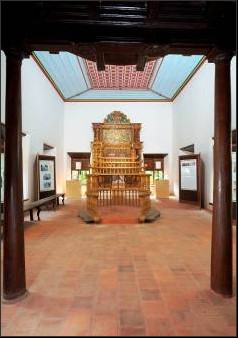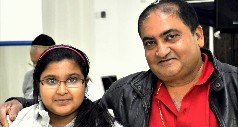CHENNAMANGALAM SYNAGOGUE (16TH century, but rebuilt and altered over the years)
Village of Chennamangalam (or Chendamangalam)
Kerala, INDIA
This synagogue is now closed, and today there are no Jews living in the village. Since 2006, the building has operated as a museum run by Indian Department of Archeology authorities. It should be open daily during working hours, except Mondays, when a man who manages the museum is on duty. On arrival request a brochure (hopefully still in stock) prepared by the author of this website and his colleagues of the Friends of Kerala Synagogues. An exhibition that was prepared also by this same group was on display for several years here (seen in interior photograph below), but recently it was removed by government officials with little if anything to replace it with. There is no contact number or email for this site. To visit this and other former synagogues in Kerala outside of Kochi, the services of a car and driver is recommended for a full day. Chennamanagalam and nearby Parur (Paravur) are about an hour north of Kochi (longer depending on where the trip begins). A public bus can also be taken to Chennamangalam for the more adventurous traveler. Contact the author of this website, Jay A. Waronker at This email address is being protected from spambots. You need JavaScript enabled to view it. for additional information and assistance, and refer to cochinsyn.com.
Chennamangalam’s synagogue, constructed by a small but vibrant community of Jews who settled here centuries ago, has undergone a series of changes and rebuilding efforts over the years. According to narratives, the first building dates to 1420, followed by one in 1614, and then another later that same century. Fire was the likely cause of the rebuilding efforts. It is possible that the Portuguese, who persecuted the area’s Jews in the mid-seventeenth century and set the Paradesi synagogue in Kochi’s Jew Town on fire in 1661, were also responsible for setting the Chennamangalam synagogue ablaze. Whether that synagogue was completely or partially destroyed at that time is not clear, but a fourth synagogue seemed to have been realized. Archeologists from the government of Kerala responsible for the restoration of the synagogue in 2005 have a slightly different opinion on the dates of the building. They believe it was built in 1565 and repaired in 1621.
A popular legend holds that hillocks of the town were planned at an unknown date by a tolerant Paliath Acham who sought to have four religious faiths prominently represented in town. Paliath Achans, or local chieftains and hereditary prime ministers of the rajahs of Cochin, reigned in Chennamangalam until 1809 (although descendants still live in the area). It is said that in the center of Chennamangalam he designated a site on each of the cardinal points for the construction of a palli, or religious building, for four major faiths: a Hindu temple, Muslim mosque, Christian church, and Jewish synagogue. At the crossing of the axis he set his own residence, the Paliyam Palace, on a hill that is the highest point in the village. It is true that the construction of all four places of worship were realized by the Paliath Acham. It is also the case that the four structures have for centuries stood in some form in central Chennamangalam, yet they are not positioned on the four points, and the Paliath Acham’s home is not neatly located at the axis. The prime minister’s residence dating in part to the 16th century was constructed not in the village center but rather on the edge of town.
According to the Anglican Church missionary Rev. Thomas Dawson, who visited Chennamangalam in 1816, found the synagogue in ruins. From his own visit to the area, Dawson recorded that this Jewish house of prayer and the one in Parur and Mala had been destroyed by the armies of Tipu Sultan during the Anglo-Mysore Wars. Based on Dawson’s history, the Chennamangalam synagogue could not have been rebuilt before the second decade of the 19th century.
Although the current building served the needs of this community for many years, from the mid-1950s to the turn of the new century it sat mostly unused. This was so since most of the Jews moved from Chennamangalam to Israel shortly after the establishment of the Jewish state in 1948, and this emigration continued albeit in diminished numbers for the next three decades. Unattended to during these years and into the 1990s by the tiny congregation with limited resources, the synagogue deteriorated so badly that portions of the roof and floor collapsed, large sections of the whitewashed walls eroded, and the structure was severely compromised. Vegetation consumed the building, and its doors and windows had to be sealed against the elements.
By the first years of the 21st century, the last of Chennamangalam’s Jews had emigrated or died. Around this time, the Association of Kerala Jews agreed to transfer maintenance of the synagogue to the State of Kerala. This allowed the Kerala office of the Indian Department of Archaeology to assume control of the decommissioned synagogue and embark on its needed restoration. Beginning in late 2004, under the direction of Dr. V. Manmadhan Nair and his staff, skilled restoration professionals and craftsmen brought the building back to form. At that time, an exhibition on the history of the Jewish community planned by an international team on behalf of the Association of Friends of Kerala Synagogues was installed in the newly restored building.
The Chennamangalam synagogue sits near the center of the quiet village. In the immediate area of the synagogue are a few homes, some once Jewish owned. In the Kerala synagogue tradition, the one at Chennamangalam is not a single building but a collection of connected pieces surrounded by a high wall constructed of laterite stone veneered in whitewashed chunam (polished lime). The synagogue compound, the smallest of the seven extant Kerala synagogues, can best be described as a ‘peninsula’ arrangement where the perimeter wall aligns with the façade of the synagogue yet frees itself of the building along the other three sides. The two story steeply gabled synagogue is a modest soft-edged whitewashed structure also built of laterite load-bearing walls veneered in chunam. The wall surfaces feature limited ornamentation that includes, in the Portuguese colonial Kerala, quadrantal fan-like alettes with radiating striations at the attic and shallow pilasters with simple capitals yet no bases at the second floor. The so-called pilasters frame the second floor windows, which consist of a rounded arched transom set above a rectangular unit. The wood framed openings are placed deeply in the thick walls. Also set deeply in the thick wall are the rounded arch entrance doors made of planks of wood. In Kerala fashion, they are designed as doors within doors. Centered near the apex of the front gable is a circular attic vent with a floral or star pattern inset. Such a detail, a vernacular Kerala feature, was influenced by Portuguese colonial architecture in India.
The entry into the Chennamangalam synagogue complex is along the latitudinal (east) side. Unique to the Chennamangalam synagogue from other Kerala synagogues is its deep covered porch with a second floor room above. This synagogue breaks from the tradition of other Kerala Jewish houses of prayer in that it also does not have a gatehouse. The building’s recessed porch, although different from the two-story breezeways found or once existing at other Kerala synagogues, also serves as a transition and connecting zone. The porch connects to the azara, or anteroom, which is a space named after a courtyard space at the ancient Temple in Jerusalem. Beyond the azara is the sanctuary. In the tradition of Kerala synagogues, the sanctuary is entered under a gallery supported by two wooden columns flanking the entry. According to local narrative, these columns recall the Boaz and Jachim ones once found in the Temple in Jerusalem. The sanctuary’s most prominent architectural features are its painted framed ceiling with a grid of small panels each with gold-leafed lotus medallions, the lyre-shaped central tebah, shuttered windows set in thick load-bearing walls, and a beautifully hand-carved heckal fabricated out of local teak and highlighted in gold, red, and green. At one point free-standing wooden pews and a myriad of hanging fixtures and lanterns would have decorated the interior of this fine little synagogue. These elements were set off against the whitewashed chunam walls.
Centered on the gallery is a second tebah, a unique architectural and liturgical feature to Kerala synagogues. From here, the Torah scrolls were read during Shabbat and holiday prayers. Adjacent to the gallery, in Kerala synagogue tradition, is the women’s seating area. Separating these two spaces is the mechitza, or screen wall. Beyond the women’s area is a space directly above the recessed front porch that was once used a classroom for a Jewish school.

Exterior

Interior








